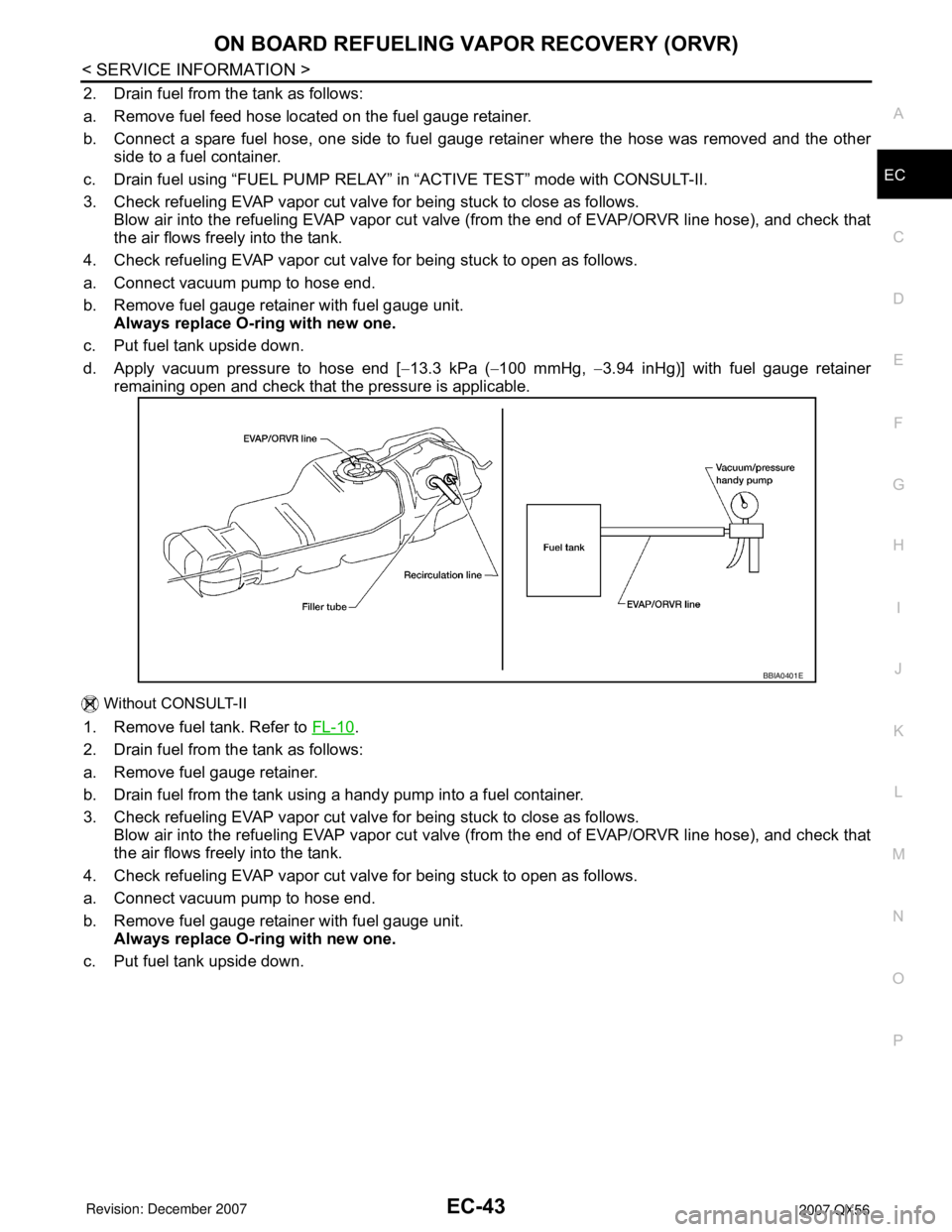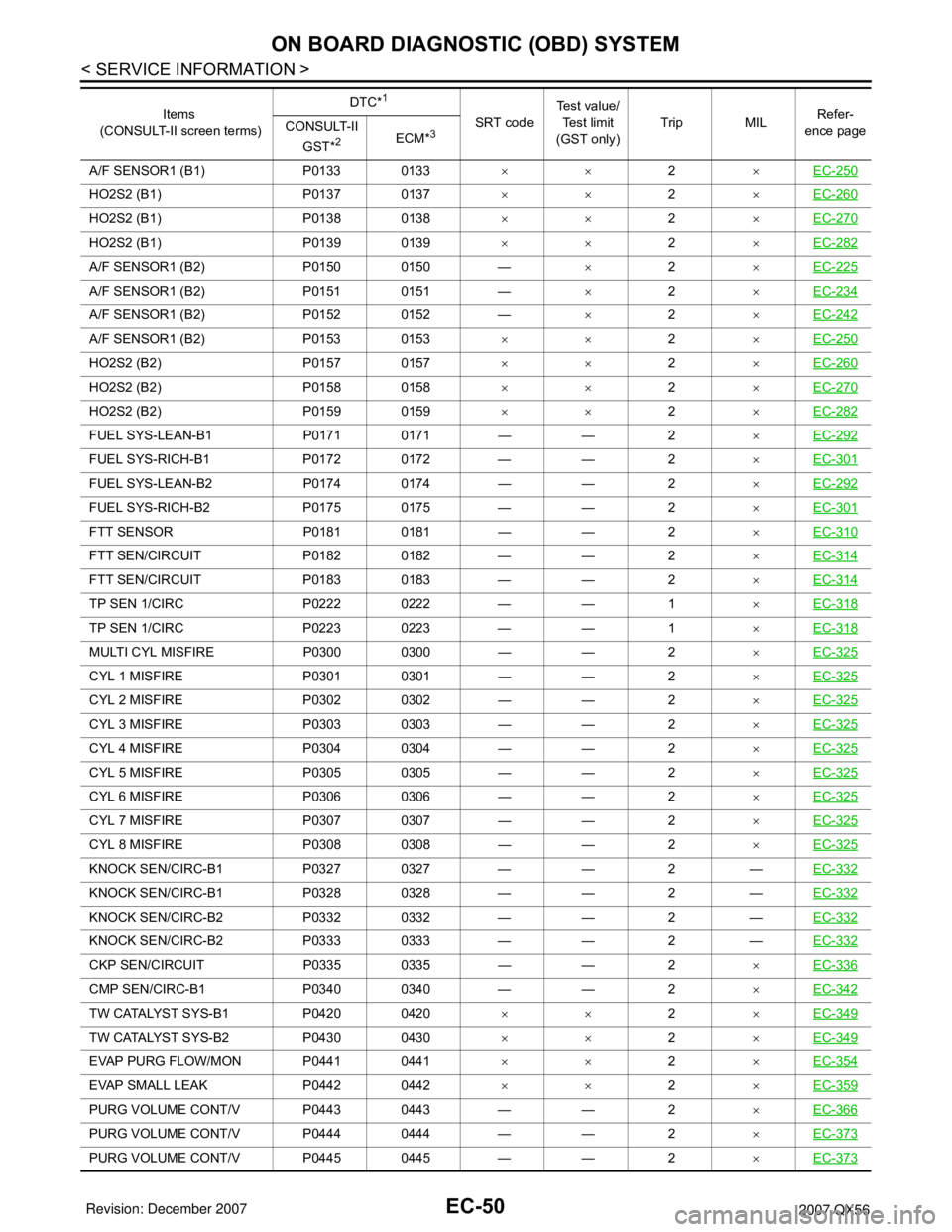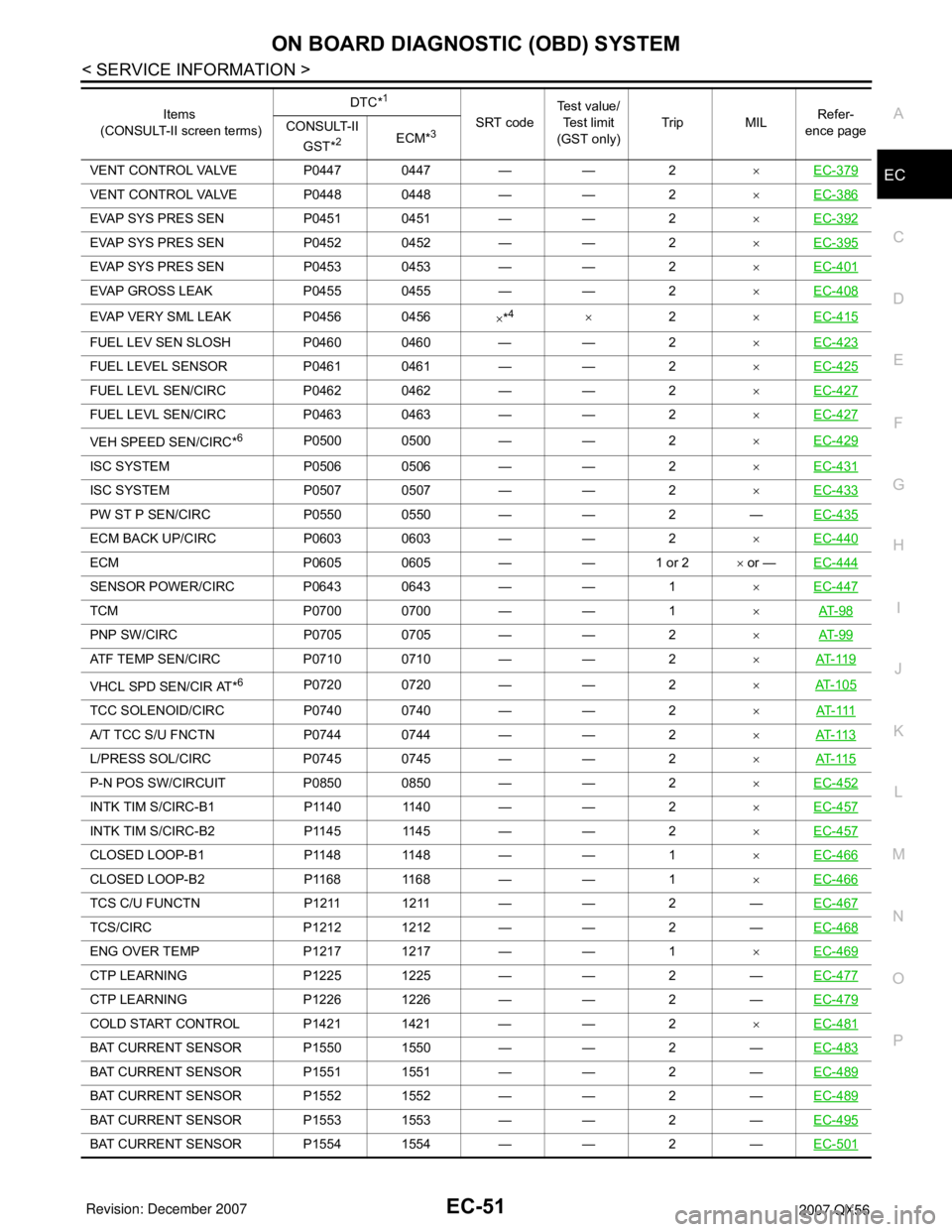2007 INFINITI QX56 fuel
[x] Cancel search: fuelPage 1126 of 3061

ON BOARD REFUELING VAPOR RECOVERY (ORVR)
EC-43
< SERVICE INFORMATION >
C
D
E
F
G
H
I
J
K
L
MA
EC
N
P O
2. Drain fuel from the tank as follows:
a. Remove fuel feed hose located on the fuel gauge retainer.
b. Connect a spare fuel hose, one side to fuel gauge retainer where the hose was removed and the other
side to a fuel container.
c. Drain fuel using “FUEL PUMP RELAY” in “ACTIVE TEST” mode with CONSULT-II.
3. Check refueling EVAP vapor cut valve for being stuck to close as follows.
Blow air into the refueling EVAP vapor cut valve (from the end of EVAP/ORVR line hose), and check that
the air flows freely into the tank.
4. Check refueling EVAP vapor cut valve for being stuck to open as follows.
a. Connect vacuum pump to hose end.
b. Remove fuel gauge retainer with fuel gauge unit.
Always replace O-ring with new one.
c. Put fuel tank upside down.
d. Apply vacuum pressure to hose end [−13.3 kPa (−100 mmHg, −3.94 inHg)] with fuel gauge retainer
remaining open and check that the pressure is applicable.
Without CONSULT-II
1. Remove fuel tank. Refer to FL-10.
2. Drain fuel from the tank as follows:
a. Remove fuel gauge retainer.
b. Drain fuel from the tank using a handy pump into a fuel container.
3. Check refueling EVAP vapor cut valve for being stuck to close as follows.
Blow air into the refueling EVAP vapor cut valve (from the end of EVAP/ORVR line hose), and check that
the air flows freely into the tank.
4. Check refueling EVAP vapor cut valve for being stuck to open as follows.
a. Connect vacuum pump to hose end.
b. Remove fuel gauge retainer with fuel gauge unit.
Always replace O-ring with new one.
c. Put fuel tank upside down.
BBIA0401E
Page 1127 of 3061
![INFINITI QX56 2007 Factory Service Manual EC-44
< SERVICE INFORMATION >
ON BOARD REFUELING VAPOR RECOVERY (ORVR)
d. Apply vacuum pressure to hose end [−13.3 kPa (−100 mmHg, −3.94 inHg)] with fuel gauge retainer
remaining open and check INFINITI QX56 2007 Factory Service Manual EC-44
< SERVICE INFORMATION >
ON BOARD REFUELING VAPOR RECOVERY (ORVR)
d. Apply vacuum pressure to hose end [−13.3 kPa (−100 mmHg, −3.94 inHg)] with fuel gauge retainer
remaining open and check](/manual-img/42/57029/w960_57029-1126.png)
EC-44
< SERVICE INFORMATION >
ON BOARD REFUELING VAPOR RECOVERY (ORVR)
d. Apply vacuum pressure to hose end [−13.3 kPa (−100 mmHg, −3.94 inHg)] with fuel gauge retainer
remaining open and check that the pressure is applicable.
BBIA0401E
Page 1132 of 3061

ON BOARD DIAGNOSTIC (OBD) SYSTEM
EC-49
< SERVICE INFORMATION >
C
D
E
F
G
H
I
J
K
L
MA
EC
N
P O
Therefore, when electrical controlled throttle and part of ECM related diagnoses are continuously detected as
NG for 5 trips, ECM warns the driver that engine control system malfunctions and MIL circuit is open by means
of operating fail-safe function.
The fail-safe function also operates when above diagnoses except MIL circuit are detected and demands the
driver to repair the malfunction.
Emission-related Diagnostic InformationINFOID:0000000003531606
EMISSION-RELATED DIAGNOSTIC INFORMATION ITEMS
×:Applicable —: Not applicable
Engine operating condition in fail-safe mode Engine speed will not rise more than 2,500 rpm due to the fuel cut
Items
(CONSULT-II screen terms)DTC*
1
SRT codeTe s t v a l u e /
Test limit
(GST only)Trip MILRefer-
ence page CONSULT-II
GST*
2ECM*3
CAN COMM CIRCUIT U1000
1000*5—— 1×EC-145
CAN COMM CIRCUIT U1001
1001*5——1 or 2
2*10—EC-145
CONTROL UNIT(CAN) U1010 1010 — — 1×EC-147
NO DTC IS DETECTED.
FURTHER TESTING
MAY BE REQUIRED.P0000 0000———
Flashing*7EC-63
INT/V TIM CONT-B1 P0011 0011 — — 2×EC-149
INT/V TIM CONT-B2 P0021 0021 — — 2×EC-149
A/F SEN1 HTR (B1) P0031 0031 —×2×EC-163
A/F SEN1 HTR (B1) P0032 0032 —×2×EC-163
HO2S2 HTR (B1) P0037 0037 —×2×EC-170
HO2S2 HTR (B1) P0038 0038 —×2×EC-170
A/F SEN1 HTR (B2) P0051 0051 —×2×EC-163
A/F SEN1 HTR (B2) P0052 0052 —×2×EC-163
HO2S2 HTR (B2) P0057 0057 —×2×EC-170
HO2S2 HTR (B2) P0058 0058 —×2×EC-170
INT/V TIM V/CIR-B1 P0075 0075 — — 2×EC-178
INT/V TIM V/CIR-B2 P0081 0081 — — 2×EC-178
MAF SEN/CIRCUIT P0101 0101 — — 2×EC-186
MAF SEN/CIRCUIT P0102 0102 — — 1×EC-194
MAF SEN/CIRCUIT P0103 0103 — — 1×EC-194
IAT SEN/CIRCUIT P0112 0112 — — 2×EC-201
IAT SEN/CIRCUIT P0113 0113 — — 2×EC-201
ECT SEN/CIRC P0117 0117 — — 1×EC-205
ECT SEN/CIRC P0118 0118 — — 1×EC-205
TP SEN 2/CIRC P0122 0122 — — 1×EC-210
TP SEN 2/CIRC P0123 0123 — — 1×EC-210
ECT SENSOR P0125 0125 — — 2×EC-217
IAT SENSOR P0127 0127 — — 2×EC-220
THERMSTAT FNCTN P0128 0128 — — 2×EC-223
A/F SENSOR1 (B1) P0130 0130 —×2×EC-225
A/F SENSOR1 (B1) P0131 0131 —×2×EC-234
A/F SENSOR1 (B1) P0132 0132 —×2×EC-242
Page 1133 of 3061

EC-50
< SERVICE INFORMATION >
ON BOARD DIAGNOSTIC (OBD) SYSTEM
A/F SENSOR1 (B1) P0133 0133××2×EC-250
HO2S2 (B1) P0137 0137××2×EC-260
HO2S2 (B1) P0138 0138××2×EC-270
HO2S2 (B1) P0139 0139××2×EC-282
A/F SENSOR1 (B2) P0150 0150 —×2×EC-225
A/F SENSOR1 (B2) P0151 0151 —×2×EC-234
A/F SENSOR1 (B2) P0152 0152 —×2×EC-242
A/F SENSOR1 (B2) P0153 0153××2×EC-250
HO2S2 (B2) P0157 0157××2×EC-260
HO2S2 (B2) P0158 0158××2×EC-270
HO2S2 (B2) P0159 0159××2×EC-282
FUEL SYS-LEAN-B1 P0171 0171 — — 2×EC-292
FUEL SYS-RICH-B1 P0172 0172 — — 2×EC-301
FUEL SYS-LEAN-B2 P0174 0174 — — 2×EC-292
FUEL SYS-RICH-B2 P0175 0175 — — 2×EC-301
FTT SENSOR P0181 0181 — — 2×EC-310
FTT SEN/CIRCUIT P0182 0182 — — 2×EC-314
FTT SEN/CIRCUIT P0183 0183 — — 2×EC-314
TP SEN 1/CIRC P0222 0222 — — 1×EC-318
TP SEN 1/CIRC P0223 0223 — — 1×EC-318
MULTI CYL MISFIRE P0300 0300 — — 2×EC-325
CYL 1 MISFIRE P0301 0301 — — 2×EC-325
CYL 2 MISFIRE P0302 0302 — — 2×EC-325
CYL 3 MISFIRE P0303 0303 — — 2×EC-325
CYL 4 MISFIRE P0304 0304 — — 2×EC-325
CYL 5 MISFIRE P0305 0305 — — 2×EC-325
CYL 6 MISFIRE P0306 0306 — — 2×EC-325
CYL 7 MISFIRE P0307 0307 — — 2×EC-325
CYL 8 MISFIRE P0308 0308 — — 2×EC-325
KNOCK SEN/CIRC-B1 P0327 0327 — — 2 —EC-332
KNOCK SEN/CIRC-B1 P0328 0328 — — 2 —EC-332
KNOCK SEN/CIRC-B2 P0332 0332 — — 2 —EC-332
KNOCK SEN/CIRC-B2 P0333 0333 — — 2 —EC-332
CKP SEN/CIRCUIT P0335 0335 — — 2×EC-336
CMP SEN/CIRC-B1 P0340 0340 — — 2×EC-342
TW CATALYST SYS-B1 P0420 0420××2×EC-349
TW CATALYST SYS-B2 P0430 0430××2×EC-349
EVAP PURG FLOW/MON P0441 0441××2×EC-354
EVAP SMALL LEAK P0442 0442××2×EC-359
PURG VOLUME CONT/V P0443 0443 — — 2×EC-366
PURG VOLUME CONT/V P0444 0444 — — 2×EC-373
PURG VOLUME CONT/V P0445 0445 — — 2×EC-373
Items
(CONSULT-II screen terms)DTC*
1
SRT codeTest value/
Test limit
(GST only)Trip MILRefer-
ence page CONSULT-II
GST*
2ECM*3
Page 1134 of 3061

ON BOARD DIAGNOSTIC (OBD) SYSTEM
EC-51
< SERVICE INFORMATION >
C
D
E
F
G
H
I
J
K
L
MA
EC
N
P OVENT CONTROL VALVE P0447 0447 — — 2×EC-379
VENT CONTROL VALVE P0448 0448 — — 2×EC-386
EVAP SYS PRES SEN P0451 0451 — — 2×EC-392
EVAP SYS PRES SEN P0452 0452 — — 2×EC-395
EVAP SYS PRES SEN P0453 0453 — — 2×EC-401
EVAP GROSS LEAK P0455 0455 — — 2×EC-408
EVAP VERY SML LEAK P0456 0456
×*4×2×EC-415
FUEL LEV SEN SLOSH P0460 0460 — — 2×EC-423
FUEL LEVEL SENSOR P0461 0461 — — 2×EC-425
FUEL LEVL SEN/CIRC P0462 0462 — — 2×EC-427
FUEL LEVL SEN/CIRC P0463 0463 — — 2×EC-427
VEH SPEED SEN/CIRC*6P0500 0500 — — 2×EC-429
ISC SYSTEM P0506 0506 — — 2×EC-431
ISC SYSTEM P0507 0507 — — 2×EC-433
PW ST P SEN/CIRC P0550 0550 — — 2 —EC-435
ECM BACK UP/CIRC P0603 0603 — — 2×EC-440
ECM P0605 0605 — — 1 or 2× or —EC-444
SENSOR POWER/CIRC P0643 0643 — — 1×EC-447
TCM P0700 0700 — — 1×AT- 9 8
PNP SW/CIRC P0705 0705 — — 2×AT- 9 9
ATF TEMP SEN/CIRC P0710 0710 — — 2×AT- 11 9
VHCL SPD SEN/CIR AT*6P0720 0720 — — 2×AT- 1 0 5
TCC SOLENOID/CIRC P0740 0740 — — 2×AT- 111
A/T TCC S/U FNCTN P0744 0744 — — 2×AT- 11 3
L/PRESS SOL/CIRC P0745 0745 — — 2×AT- 11 5
P-N POS SW/CIRCUIT P0850 0850 — — 2×EC-452
INTK TIM S/CIRC-B1 P1140 1140 — — 2×EC-457
INTK TIM S/CIRC-B2 P1145 1145 — — 2×EC-457
CLOSED LOOP-B1 P1148 1148 — — 1×EC-466
CLOSED LOOP-B2 P1168 1168 — — 1×EC-466
TCS C/U FUNCTN P1211 1211 — — 2 —EC-467
TCS/CIRC P1212 1212 — — 2 —EC-468
ENG OVER TEMP P1217 1217 — — 1×EC-469
CTP LEARNING P1225 1225 — — 2 —EC-477
CTP LEARNING P1226 1226 — — 2 —EC-479
COLD START CONTROL P1421 1421 — — 2×EC-481
BAT CURRENT SENSOR P1550 1550 — — 2 —EC-483
BAT CURRENT SENSOR P1551 1551 — — 2 —EC-489
BAT CURRENT SENSOR P1552 1552 — — 2 —EC-489
BAT CURRENT SENSOR P1553 1553 — — 2 —EC-495
BAT CURRENT SENSOR P1554 1554 — — 2 —EC-501
Items
(CONSULT-II screen terms)DTC*
1
SRT codeTe s t v a l u e /
Test limit
(GST only)Trip MILRefer-
ence page CONSULT-II
GST*
2ECM*3
Page 1137 of 3061

EC-54
< SERVICE INFORMATION >
ON BOARD DIAGNOSTIC (OBD) SYSTEM
A sample of CONSULT-II display for DTC and 1st trip DTC is shown below. DTC or 1st trip DTC of a malfunc-
tion is displayed in SELF-DIAGNOSTIC RESULTS mode of CONSULT-II. Time data indicates how many times
the vehicle was driven after the last detection of a DTC.
If the DTC is being detected currently, the time data will be [0].
If a 1st trip DTC is stored in the ECM, the time data will be [1t].
FREEZE FRAME DATA AND 1ST TRIP FREEZE FRAME DATA
The ECM records the driving conditions such as fuel system status, calculated load value, engine coolant tem-
perature, short term fuel trim, long term fuel trim, engine speed, vehicle speed, absolute throttle position, base
fuel schedule and intake air temperature at the moment a malfunction is detected.
Data which are stored in the ECM memory, along with the 1st trip DTC, are called 1st trip freeze frame data.
The data, stored together with the DTC data, are called freeze frame data and displayed on CONSULT-II or
GST. The 1st trip freeze frame data can only be displayed on the CONSULT-II screen, not on the GST. For
details, see E C - 111 , "
CONSULT-II Function (ENGINE)".
Only one set of freeze frame data (either 1st trip freeze frame data or freeze frame data) can be stored in the
ECM. 1st trip freeze frame data is stored in the ECM memory along with the 1st trip DTC. There is no priority
for 1st trip freeze frame data and it is updated each time a different 1st trip DTC is detected. However, once
freeze frame data (2nd trip detection/MIL on) is stored in the ECM memory, 1st trip freeze frame data is no
longer stored. Remember, only one set of freeze frame data can be stored in the ECM. The ECM has the fol-
lowing priorities to update the data.
For example, the EGR malfunction (Priority: 2) was detected and the freeze frame data was stored in the 2nd
trip. After that when the misfire (Priority: 1) is detected in another trip, the freeze frame data will be updated
from the EGR malfunction to the misfire. The 1st trip freeze frame data is updated each time a different mal-
function is detected. There is no priority for 1st trip freeze frame data. However, once freeze frame data is
stored in the ECM memory, 1st trip freeze data is no longer stored (because only one freeze frame data or 1st
trip freeze frame data can be stored in the ECM). If freeze frame data is stored in the ECM memory and freeze
frame data with the same priority occurs later, the first (original) freeze frame data remains unchanged in the
ECM memory.
Both 1st trip freeze frame data and freeze frame data (along with the DTCs) are cleared when the ECM mem-
ory is erased. Procedures for clearing the ECM memory are described in "HOW TO ERASE EMISSION-
RELATED DIAGNOSTIC INFORMATION".
SYSTEM READINESS TEST (SRT) CODE
System Readiness Test (SRT) code is specified in Service $01 of SAE J1979.
As part of an enhanced emissions test for Inspection & Maintenance (I/M), certain states require the status of
SRT be used to indicate whether the ECM has completed self-diagnosis of major emission systems and com-
ponents. Completion must be verified in order for the emissions inspection to proceed.
If a vehicle is rejected for a State emissions inspection due to one or more SRT items indicating “INCMP”, use
the information in this Service Manual to set the SRT to “CMPLT”.
In most cases the ECM will automatically complete its self-diagnosis cycle during normal usage, and the SRT
status will indicate “CMPLT” for each application system. Once set as “CMPLT”, the SRT status remains
“CMPLT” until the self-diagnosis memory is erased.
Occasionally, certain portions of the self-diagnostic test may not be completed as a result of the customer's
normal driving pattern; the SRT will indicate “INCMP” for these items.
PBIB0911E
Priority Items
1Freeze frame data Misfire — DTC: P0300 - P0308
Fuel Injection System Function — DTC: P0171, P0172, P0174, P0175
2 Except the above items (Includes A/T related items)
3 1st trip freeze frame data
Page 1138 of 3061

ON BOARD DIAGNOSTIC (OBD) SYSTEM
EC-55
< SERVICE INFORMATION >
C
D
E
F
G
H
I
J
K
L
MA
EC
N
P O
NOTE:
The SRT will also indicate “INCMP” if the self-diagnosis memory is erased for any reason or if the ECM mem-
ory power supply is interrupted for several hours.
If, during the state emissions inspection, the SRT indicates “CMPLT” for all test items, the inspector will con-
tinue with the emissions test. However, if the SRT indicates “INCMP” for one or more of the SRT items the
vehicle is returned to the customer untested.
NOTE:
If MIL is ON during the state emissions inspection, the vehicle is also returned to the customer untested even
though the SRT indicates “CMPLT” for all test items. Therefore, it is important to check SRT (“CMPLT”) and
DTC (No DTCs) before the inspection.
SRT Item
The table below shows required self-diagnostic items to set the SRT to “CMPLT”.
*: If completion of several SRTs is required, perform driving patterns (DTC confirmation procedure), one by one based on the priority for
models with CONSULT-II.
SRT Set Timing
SRT is set as “CMPLT” after self-diagnosis has been performed one or more times. Completion of SRT is
done regardless of whether the result is OK or NG. The set timing is different between OK and NG results and
is shown in the table below.
OK: Self-diagnosis is carried out and the result is OK.
NG: Self-diagnosis is carried out and the result is NG.
—: Self-diagnosis is not carried out.SRT item
(CONSULT-II indication)Performance
Priority*Required self-diagnostic items to set the SRT to “CMPLT”Corresponding
DTC No.
CATALYST 2 Three way catalyst function P0420, P0430
EVAP SYSTEM 2 EVAP control system purge flow monitoring P0441
1 EVAP control system P0442
2 EVAP control system P0456
HO2S 2 Air fuel ratio (A/F) sensor 1 P0133, P0153
Heated oxygen sensor 2 P0137, P0157
Heated oxygen sensor 2 P0138, P0158
Heated oxygen sensor 2 P0139, P0159
Self-diagnosis resultExample
DiagnosisIgnition cycle
← ON → OFF ← ON → OFF ← ON → OFF ← ON →
All OK Case 1 P0400 OK (1) — (1) OK (2) — (2)
P0402 OK (1) — (1) — (1) OK (2)
P1402 OK (1) OK (2) — (2) — (2)
SRT of EGR “CMPLT” “CMPLT” “CMPLT” “CMPLT”
Case 2 P0400 OK (1) — (1) — (1) — (1)
P0402 — (0) — (0) OK (1) — (1)
P1402 OK (1) OK (2) — (2) — (2)
SRT of EGR “INCMP” “INCMP” “CMPLT” “CMPLT”
NG exists Case 3 P0400 OK OK — —
P0402 — — — —
P1402 NG — NGNG
(Consecutive
NG)
(1st trip)
DTC1st trip DTC — 1st trip DTCDTC
(= MIL ON)
SRT of EGR “INCMP” “INCMP” “INCMP” “CMPLT”
Page 1143 of 3061

EC-60
< SERVICE INFORMATION >
ON BOARD DIAGNOSTIC (OBD) SYSTEM
• Sea level
• Flat road
• Ambient air temperature: 20 - 30°C (68 - 86°F)
• Diagnosis is performed as quickly as possible under normal conditions.
Under different conditions [For example: ambient air temperature other than 20 - 30°C (68 - 86°F)], diagno-
sis may also be performed.
Pattern 1:
•The engine is started at the engine coolant temperature of −10 to 35°C (14 to 95°F)
(where the voltage between the ECM terminal 73 and ground is 3.0 - 4.3V).
•The engine must be operated at idle speed until the engine coolant temperature is greater than 70°C
(158°F) (where the voltage between the ECM terminal 73 and ground is lower than 1.4V).
•The engine is started at the fuel tank temperature of warmer than 0°C (32°F) (where the voltage
between the ECM terminal 107 and ground is less than 4.1V).
Pattern 2:
• When steady-state driving is performed again even after it is interrupted, each diagnosis can be conducted.
In this case, the time required for diagnosis may be extended.
Pattern 3:
• Operate vehicle following the driving pattern shown in the figure.
• Release the accelerator pedal during decelerating vehicle speed
from 90 km/h (56 MPH) to 0 km/h (0 MPH).
Pattern 4:
• The accelerator pedal must be held very steady during steady-
state driving.
• If the accelerator pedal is moved, the test must be conducted all
over again.
*1: Depress the accelerator pedal until vehicle speed is 90 km/h (56
MPH), then release the accelerator pedal and keep it released for
more than 10 seconds. Depress the accelerator pedal until vehicle
speed is 90 km/h (56 MPH) again.
*2: Checking the vehicle speed with GST is advised.
Suggested Transmission Gear Position
Set the selector lever in the D position with the overdrive switch turned ON.
TEST VALUE AND TEST LIMIT (GST ONLY — NOT APPLICABLE TO CONSULT-II)
The following is the information specified in Service $06 of SAE J1979.
The test value is a parameter used to determine whether a system/circuit diagnostic test is OK or NG while
being monitored by the ECM during self-diagnosis. The test limit is a reference value which is specified as the
maximum or minimum value and is compared with the test value being monitored.
These data (test value and test limit) are specified by Test ID (TID) and Component ID (CID) and can be dis-
played on the GST screen.
PBIB2244E
Item Self-diagnostic test item DTCTest value (GST display)
Test limit Conversion
TID CID
CATALYSTThree way catalyst function (Bank 1)P0420 01H 01H Max. 1/128
P0420 02H 81H Min. 1
Three way catalyst function (Bank 2)P0430 03H 02H Max. 1/128
P0430 04H 82H Min. 1
EVAP
SYSTEMEVAP control system (Small leak) P0442 05H 03H Max.
1/128 mm
2
EVAP control system purge flow monitoring P0441 06H 83H Min. 20 mV
EVAP control system (Very small leak) P0456 07H 03H Max.
1/128 mm
2